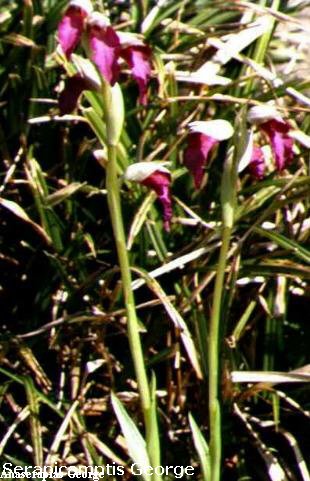|


Comments to the offered plants:
Anacamptis (Orchis ) morio X Serapias
lingua = Serapicamptis George.
Up to 40cm tall. Large, intense
red flowers. Looks like a large Serapias. Easy to grow. Needs some
protection from the hardest frosts.
Anacamptis (Orchis) morio
X Serapias orientalis. This cross produces very large
red flowers. Easy to grow. Needs some protection from the hardest
frosts.
|
Description:
Serapicamptis is a bigeneric hybrid between the genera Anacamptis
(Orchis) and Serapias. All species of Anacamptis (as defined by
Pridgeon et al. 1997) with 2n=36(32) chromosomes are crossable with
Serapias (2n=36). The remaining species within the genus Orchis
with 2n=42 chromosomes are not crossable with Serapias. In every
case, Serapias is the dominating parent and the resulting plants
look like a Serapias.
Culture:
Serapicamptis is easy in cultivation. All plants are summer
dormant and rest as tuberoids. Plants emerge in late summer and
flower in spring and early summer. Culture sunny or lightly shaded.
Outside garden culture is possible in Middle Europe. Frost hardy
up to -10°C. To avoid strong bare frosts give the plants some protection
during the coldest months. Regular watering during the growing period
is essential. Pot cultured Serapicamptis should be fertilized on
a regular basis with 0.3g/l until flowering, once or twice a month.
Outside it grows best in a more fertile soil. Reduce watering with
the onset of flowers and stop as the leaves die back. Summer rain
during dormany is not harmful in well drained soils. Completely
dry during dormancy in pot culture. Occasionally a light spray of
water for small plants and seedlings to prevent dehydration. If
grown inside, move plants temporary outside in late summer as cool
nights and some rain will stimulate plants into the new growing
season.
Recommended potting mixes:
70% Seramis, fine to medium grade perlite, pumice or fine expanded
clay give good results. 30% organic components. Favourable are fermented
or N-impregnated wood shavings or saw dust. (Toresa has given good
results.) 30% peatbased mixes as TKS1 have given even good
results. Spagnum moss is not suitable. Substrates have to be well
draining with a pH of about 6.
Further reading:
Orchids of Britain & Europe. Pierre Delforge, 1995.
Collins Photo Guide. ISBN 0 00 2200244.
Orchideen im Garten: Verwendung, Pflege und Vermehrung. Gerd
Kohls und Ulrich Kähler, 1993. Parey ISBN 3 489 63624 4.
Orchideen für den Garten: Europäische und tropische Erdorchideen.
Alfons Bürger, 1992. Ulmer ISBN 3 8001 6487 6.
Hardy orchids. Phillip Cribb and Christopher Bailes, 1989.
Timber Pr. ISBN 0 88192 147 5.
|

